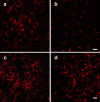Guanosine reduces apoptosis and inflammation associated with restoration of function in rats with acute spinal cord injury
- PMID: 18404454
- PMCID: PMC2072916
- DOI: 10.1007/s11302-007-9079-6
Guanosine reduces apoptosis and inflammation associated with restoration of function in rats with acute spinal cord injury
Abstract
Spinal cord injury results in progressive waves of secondary injuries, cascades of noxious pathological mechanisms that substantially exacerbate the primary injury and the resultant permanent functional deficits. Secondary injuries are associated with inflammation, excessive cytokine release, and cell apoptosis. The purine nucleoside guanosine has significant trophic effects and is neuroprotective, antiapoptotic in vitro, and stimulates nerve regeneration. Therefore, we determined whether systemic administration of guanosine could protect rats from some of the secondary effects of spinal cord injury, thereby reducing neurological deficits. Systemic administration of guanosine (8 mg/kg per day, i.p.) for 14 consecutive days, starting 4 h after moderate spinal cord injury in rats, significantly improved not only motor and sensory functions, but also recovery of bladder function. These improvements were associated with reduction in the inflammatory response to injury, reduction of apoptotic cell death, increased sparing of axons, and preservation of myelin. Our data indicate that the therapeutic action of guanosine probably results from reducing inflammation resulting in the protection of axons, oligodendrocytes, and neurons and from inhibiting apoptotic cell death. These data raise the intriguing possibility that guanosine may also be able to reduce secondary pathological events and thus improve functional outcome after traumatic spinal cord injury in humans.
Figures









Similar articles
-
Guanosine promotes myelination and functional recovery in chronic spinal injury.Neuroreport. 2003 Dec 19;14(18):2463-7. doi: 10.1097/00001756-200312190-00034. Neuroreport. 2003. PMID: 14663211
-
Erythropoietin-mediated preservation of the white matter in rat spinal cord injury.Neuroscience. 2007 Feb 9;144(3):865-77. doi: 10.1016/j.neuroscience.2006.10.023. Epub 2006 Dec 4. Neuroscience. 2007. PMID: 17141961
-
Cytoplasmic extracts from adipose tissue stromal cells alleviates secondary damage by modulating apoptosis and promotes functional recovery following spinal cord injury.Brain Pathol. 2007 Jul;17(3):263-75. doi: 10.1111/j.1750-3639.2007.00070.x. Epub 2007 Apr 23. Brain Pathol. 2007. PMID: 17465991 Free PMC article.
-
Biomaterial-supported MSC transplantation enhances cell-cell communication for spinal cord injury.Stem Cell Res Ther. 2021 Jan 7;12(1):36. doi: 10.1186/s13287-020-02090-y. Stem Cell Res Ther. 2021. PMID: 33413653 Free PMC article. Review.
-
Promoting axonal myelination for improving neurological recovery in spinal cord injury.J Neurotrauma. 2009 Oct;26(10):1847-56. doi: 10.1089/neu.2008.0551. J Neurotrauma. 2009. PMID: 19785544 Review.
Cited by
-
Hyperbaric oxygen therapy reduces apoptosis after spinal cord injury in rats.Int J Clin Exp Med. 2014 Nov 15;7(11):4073-81. eCollection 2014. Int J Clin Exp Med. 2014. PMID: 25550916 Free PMC article.
-
The hydrolysis of striatal adenine- and guanine-based purines in a 6-hydroxydopamine rat model of Parkinson's disease.Neurochem Res. 2011 Feb;36(2):215-22. doi: 10.1007/s11064-010-0305-1. Epub 2010 Nov 4. Neurochem Res. 2011. PMID: 21046237
-
Tamoxifen reduces infiltration of inflammatory cells, apoptosis and inhibits IKK/NF-kB pathway after spinal cord injury in rats.Neurol Sci. 2014 Nov;35(11):1763-8. doi: 10.1007/s10072-014-1828-z. Epub 2014 May 30. Neurol Sci. 2014. PMID: 24873902
-
A new device for step-down inhibitory avoidance task--effects of low and high frequency in a novel device for passive inhibitory avoidance task that avoids bioimpedance variations.PLoS One. 2015 Feb 23;10(2):e0116000. doi: 10.1371/journal.pone.0116000. eCollection 2015. PLoS One. 2015. PMID: 25706879 Free PMC article.
-
Mechanisms involved in the antinociception induced by systemic administration of guanosine in mice.Br J Pharmacol. 2010 Mar;159(6):1247-63. doi: 10.1111/j.1476-5381.2009.00597.x. Epub 2010 Feb 2. Br J Pharmacol. 2010. PMID: 20132210 Free PMC article.
References
-
- {'text': '', 'ref_index': 1, 'ids': [{'type': 'DOI', 'value': '10.1089/neu.2004.21.1355', 'is_inner': False, 'url': 'https://doi.org/10.1089/neu.2004.21.1355'}, {'type': 'PubMed', 'value': '15672627', 'is_inner': True, 'url': 'https://pubmed.ncbi.nlm.nih.gov/15672627/'}]}
- Ackery A, Tator C, Krassioukov A (2004) A global perspective on spinal cord injury epidemiology. J Neurotrauma 21:1355–1370 - PubMed
-
- {'text': '', 'ref_index': 1, 'ids': [{'type': 'PubMed', 'value': '8618960', 'is_inner': True, 'url': 'https://pubmed.ncbi.nlm.nih.gov/8618960/'}]}
- Schwab ME, Bartholdi D (1996) Degeneration and regeneration of axons in the lesioned spinal cord. Physiol Rev 76:319–370 - PubMed
-
- {'text': '', 'ref_index': 1, 'ids': [{'type': 'PubMed', 'value': '12443996', 'is_inner': True, 'url': 'https://pubmed.ncbi.nlm.nih.gov/12443996/'}]}
- Hulsebosch CE (2002) Recent advances in pathophysiology and treatment of spinal cord injury. Adv Physiol Educ 26:238–255 - PubMed
-
- {'text': '', 'ref_index': 1, 'ids': [{'type': 'PubMed', 'value': '8366338', 'is_inner': True, 'url': 'https://pubmed.ncbi.nlm.nih.gov/8366338/'}]}
- Nath M, Wheeler JS Jr, Walter JS (1993) Urologic aspects of traumatic central cord syndrome. J Am Paraplegia Soc 16:160–164 - PubMed
-
- {'text': '', 'ref_index': 1, 'ids': [{'type': 'DOI', 'value': '10.1097/00001756-200312190-00034', 'is_inner': False, 'url': 'https://doi.org/10.1097/00001756-200312190-00034'}, {'type': 'PubMed', 'value': '14663211', 'is_inner': True, 'url': 'https://pubmed.ncbi.nlm.nih.gov/14663211/'}]}
- Jiang S, Khan MI, Lu Y, Wang J, Buttigieg J, Werstiuk ES, Ciccarelli R, Caciagli F, Rathbone MP (2003) Guanosine promotes remyelination and functional recovery in chronic spinal injury. Neuroreport 14:2463–2467 - PubMed
LinkOut - more resources
Full Text Sources
Other Literature Sources

